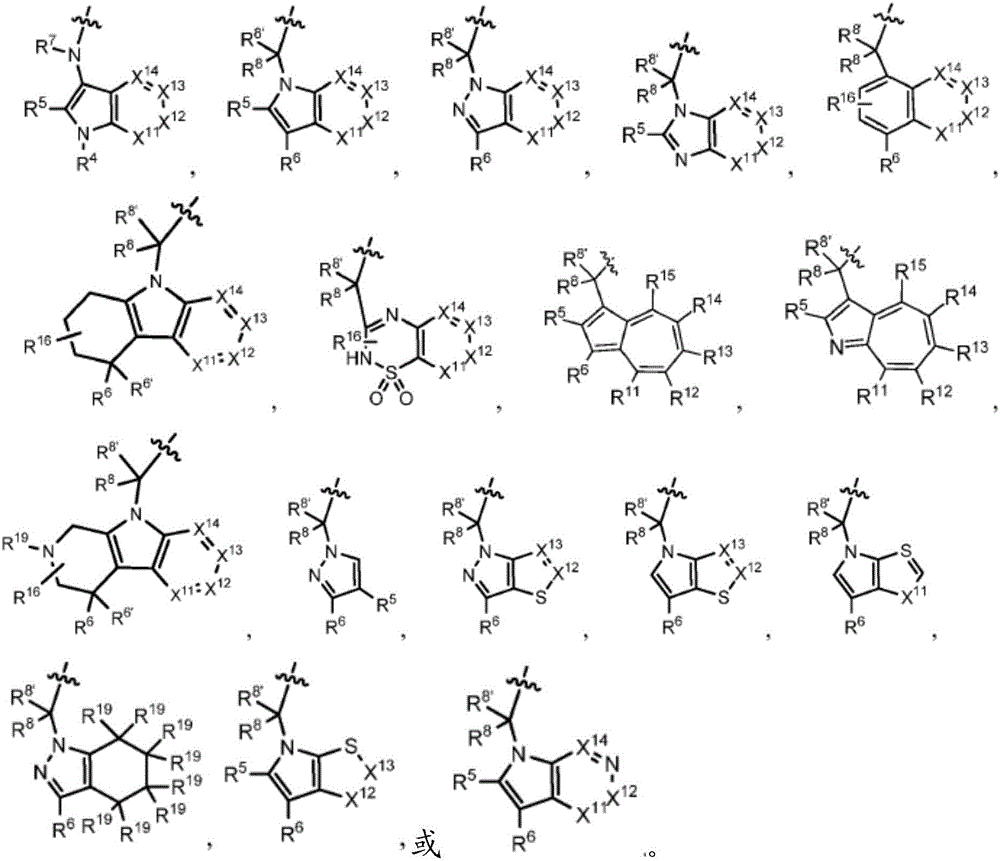Amide compounds for treatment of complement mediated disorders
一种化合物、药学的技术,应用在用于治疗补体介导的疾病的酰胺化合物领域,能够解决化合物缺乏特异性、半衰期短等问题
- Summary
- Abstract
- Description
- Claims
- Application Information
AI Technical Summary
Problems solved by technology
Method used
Image
Examples
Embodiment 1
[0462] Embodiment 1: general synthetic route
[0463] Compounds of the invention are prepared from, for example, a central core. In one embodiment, the central core structure 1 is, for example, an N-protected amino acid, where X 1 is nitrogen and PG = protecting group. In one embodiment, the central core is coupled to an amine to generate an amide of structure 2 (where L-B includes a C(O)N moiety). Structure 2 can then be deprotected to generate Structure 3 . Structure 3 is coupled to structure 4 (A-COOH) to generate a second amide bond to form a compound of formula I. This chemistry is schematically shown in Scheme 1.
[0464]
[0465] Route 1
[0466] In an alternative embodiment, the central core structure 5 is reacted with a heterocyclic or heteroaryl compound to generate a compound of structure 6. In one embodiment, structure 6 is deprotected to generate the carboxylic acid (structure 7). In one embodiment, structure 7 is coupled to an amine to generate a compou...
Embodiment 2
[0505] Example 2: Examples of central synthons
[0506]
[0507] Z A for halogen.
[0508] In one embodiment, deuterated L-proline synthons are disclosed. Deuterated synthons include, but are not limited to, compounds such as:
[0509]
[0510] Structure A can be treated with deuterium oxide to generate structure B. See Barraclough, P. et al. Tetrahedron Lett. 2005, 46, 4653-4655; Barraclough, P. et al. Org. Biomol. Chem. 2006, 4, 1483-1491 and WO 2014 / 037480 (p. 103). Structure B can be reduced to generate structure C. See Barraclough, P. et al. Tetrahedron Lett. 2005, 46, 4653-4655; Barraclough, P. et al. Org. Biomol. Chem. 2006, 4, 1483-1491. Structure C can be treated with Mitsunobu reaction conditions to generate structure D. Structure B can be processed with DAST to generate structure E. See WO 2014 / 037480. Structure A can be treated with sodium borodeuteride to generate structure F. See Dormoy, J.-R.; Castro, B. Synthesis 1986, 81-82. Compound F can be u...
Embodiment 3
[0511] Example 3: Preparation of Center-L-B Synthon
[0512]
[0513] Routes 1a, 1b and 1c
[0514] In Scheme 1a, (4S)-5-azaspiro[2.4]heptane-4,5-dicarboxylic acid, 5-(1,1-dimethylethyl)ester (CAS209269-08-9) can be Prepared as described in Tandon, M. et al. Bioorg. Med. Chem. Lett. 1998, 8, 1139-1144. In step 2, the protected azaspiro[2.4]heptane is coupled to an amine in the presence of an organic solvent, base and coupling reagent to generate an amide bond: moiety L-B. In one embodiment, the amine is (3-chloro-2-fluorophenyl)methanamine. In one embodiment, the organic solvent is DMF. In one embodiment, the base is diisopropylethylamine. In one embodiment, the coupling reagent is HATU. In step 3, the protecting group is removed. In one embodiment, the starting material is reacted with the acid in the presence of an organic solvent. In one embodiment, the acid is 4N hydrochloric acid. In one embodiment, the organic solvent is dioxane.
[0515] In Scheme 1b, (4S) 4...
PUM
 Login to View More
Login to View More Abstract
Description
Claims
Application Information
 Login to View More
Login to View More - R&D
- Intellectual Property
- Life Sciences
- Materials
- Tech Scout
- Unparalleled Data Quality
- Higher Quality Content
- 60% Fewer Hallucinations
Browse by: Latest US Patents, China's latest patents, Technical Efficacy Thesaurus, Application Domain, Technology Topic, Popular Technical Reports.
© 2025 PatSnap. All rights reserved.Legal|Privacy policy|Modern Slavery Act Transparency Statement|Sitemap|About US| Contact US: help@patsnap.com



